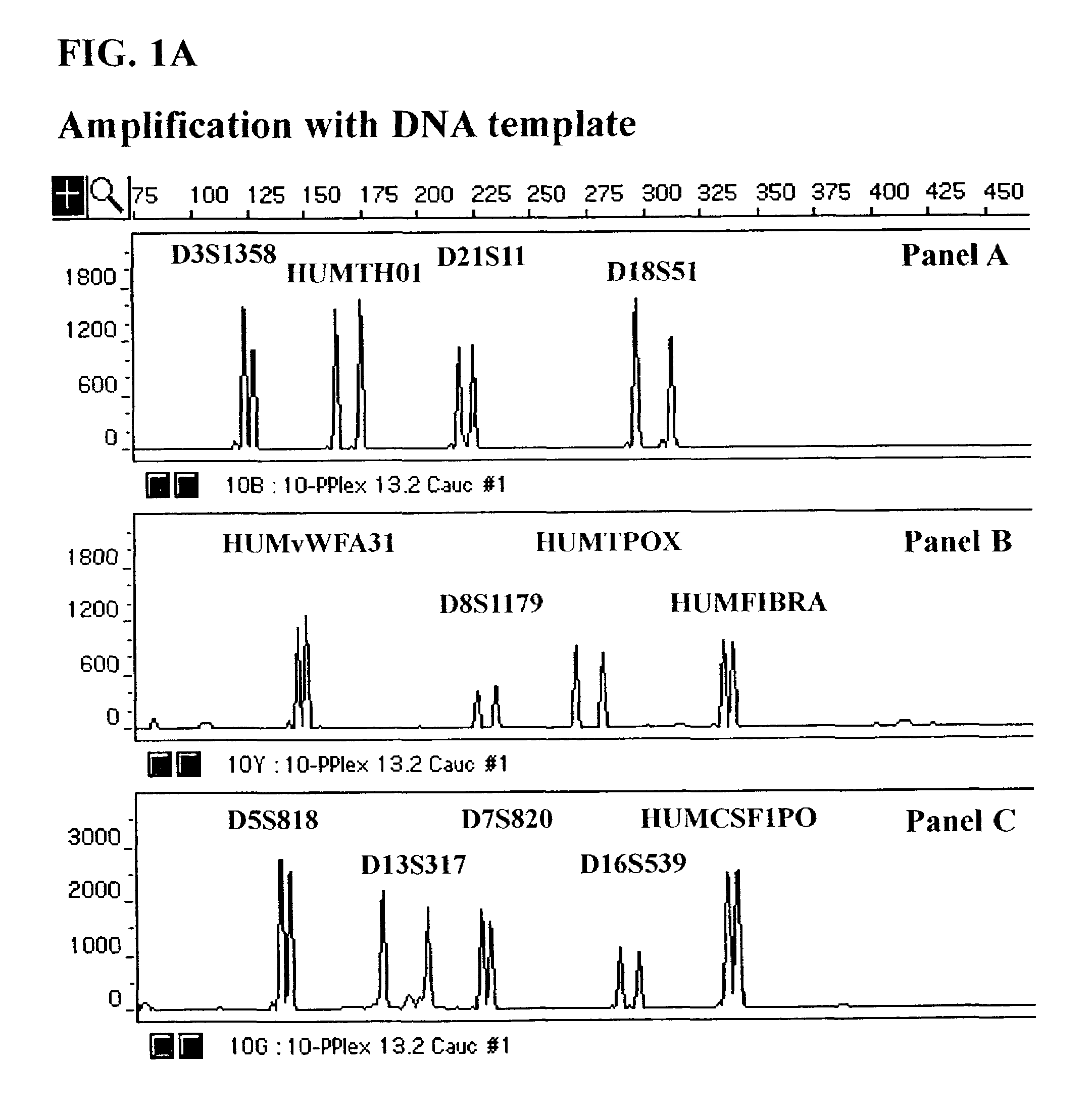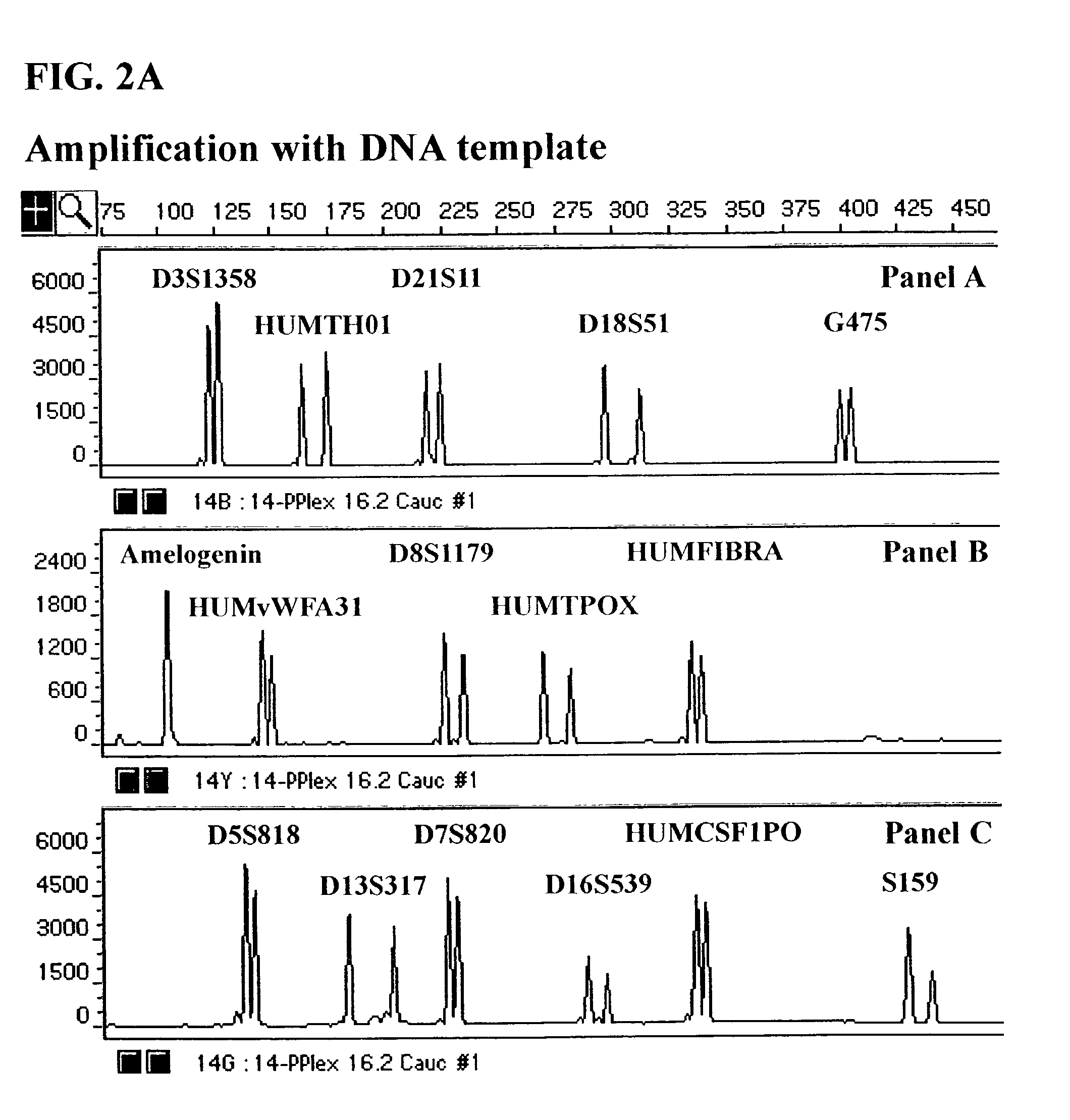Multiplex amplification of short tandem repeat loci
a technology of tandem repeats and multiple amplification, which is applied in the field of simultaneous amplification of multiple distinct polymorphic genetic loci, can solve the problems of pcr only being used to reliably amplify relatively small dna segments, and few amplifiable vntrs have been developed, so as to increase the certainty
- Summary
- Abstract
- Description
- Claims
- Application Information
AI Technical Summary
Benefits of technology
Problems solved by technology
Method used
Image
Examples
example 1
Fluorescent Detection of Multiplex Amplification of Loci D3S1358, HUMTH01, D21S11, D18S51, HUMvWFA31, D8S1179, HUMTPOX, HUMFIBRA, D5S818, D7S820, D13S317, D16S539, and HUMCSF1PO as detected with the ABI PRISM® 310 Genetic Analyzer
[0111]In this Example, a DNA template was amplified simultaneously at the individual loci D3S1358, HUMTH01, D21S11, D18S51, HUMvWFA31, D8S1179, HUMTPOX, HUMFIBRA, D5S818, D7S820, D13S317, D16S539, and HUMCSF1PO in a single reaction vessel. The PCR amplification was performed in 25 μl of 1× Gold ST*R Buffer (50 mM KCl, 10 mM Tris-HCl (pH 8.3 at 25° C.), 0.1% Triton X-100, 1.5 mM MgCl2, 160 μg / ml BSA and 200 μM each of dATP, dCTP, dGTP and dTTP) using 1 ng template, and 3.25 U AmpliTaq Gold™ DNA Polymerase. A GeneAmp® PCR System 9600 (Perkin Elmer, Foster City, Calif.) was employed with the following amplification protocol: 96° C. for 12 min., then 10 cycles of 94° C. for 30 sec., ramp for 68 sec. to 58° C., hold for 30 sec., ramp 50 sec. to 70° C., hold for ...
example 2
Fluorescent Detection of Multiplex Amplification of Loci D3S1358, HUMTH01, D21S11, D18S51, G475, Amelogenin, HUMvWFA31, D8S1179, HUMTPOX, HUMFIBRA, D5S818, D7S820, D13S317, D16S539, HUMCSF1PO, and S159 as detected with the ABI PRISM® 310 Genetic Analyzer
[0116]In this Example, a DNA template was amplified simultaneously at the individual loci D3S1358, HUMTH01, D21S11, D18S51, G475, Amelogenin, HUMvWFA31, D8S1179, HUMTPOX, HUMFIBRA, D5S818, D7S820, D13S317, D16S539, HUMCSF1PO and S159 in a single reaction vessel. The PCR amplification was performed in 25 μl of 1× Gold ST*R Buffer (50 mM KCl, 10 mM Tris-HCl (pH 8.3 at 25° C.), 0.1% Triton X-100, 1.5 mM MgCl2, 160 μg / ml BSA and 200 μM each of dATP, dCTP, dGTP and dTTP) using 1 ng template, and 4 U AmpliTaq Gold™ DNA Polymerase. A GeneAmp® PCR System 9600 (Perkin Elmer, Foster City, Calif.) was employed with the following amplification protocol: 96° C. for 12 min., then 10 cycles of 94° C. for 30 sec., ramp for 68 sec. to 58° C., hold fo...
example 3
Fluorescent Detection of Multiplex Amplification of Loci D3S1358, HUMTH01, D21S11, D18S51, G475, Amelogenin, HUMvWFA31, D8S1179, HUMTPOX, HUMFIBRA, D5S818, D7S820, D13S317, D16S539, HUMCSF1PO, and S159 as detected with the ABI PRISM® 377 DNA Sequencer
[0121]In this Example, a DNA template was amplified as in Example 2. Amplified products were separated using an ABI PRISM® 377 DNA Sequencer. This was carried out using a 0.2 mm thick, 5% Long Ranger™ Acrylamide (FMC BioProducts, Rockland, Me.), 7M urea gel. DNA samples were mixed with 1.51 μl of a loading solution (88.25% formamide, 4.1 mM EDTA, 15 mg / ml Blue Dextran) and 0.5 μl of an internal lane size standard, denatured at 95° C. for 2 min., and chilled on ice prior to loading. Electrophoresis was carried out using the manufacturer's GeneScan® modules for Prerun (PR GS 36A-2400) and Run (GS 36A-2400). Run time was 3 hours and virtual filter A was used.
[0122]FIG. 3A is a printout of results of scanning the amplified fragments of each...
PUM
| Property | Measurement | Unit |
|---|---|---|
| run temperature | aaaaa | aaaaa |
| thick | aaaaa | aaaaa |
| polymorphic | aaaaa | aaaaa |
Abstract
Description
Claims
Application Information
 Login to View More
Login to View More - R&D
- Intellectual Property
- Life Sciences
- Materials
- Tech Scout
- Unparalleled Data Quality
- Higher Quality Content
- 60% Fewer Hallucinations
Browse by: Latest US Patents, China's latest patents, Technical Efficacy Thesaurus, Application Domain, Technology Topic, Popular Technical Reports.
© 2025 PatSnap. All rights reserved.Legal|Privacy policy|Modern Slavery Act Transparency Statement|Sitemap|About US| Contact US: help@patsnap.com



